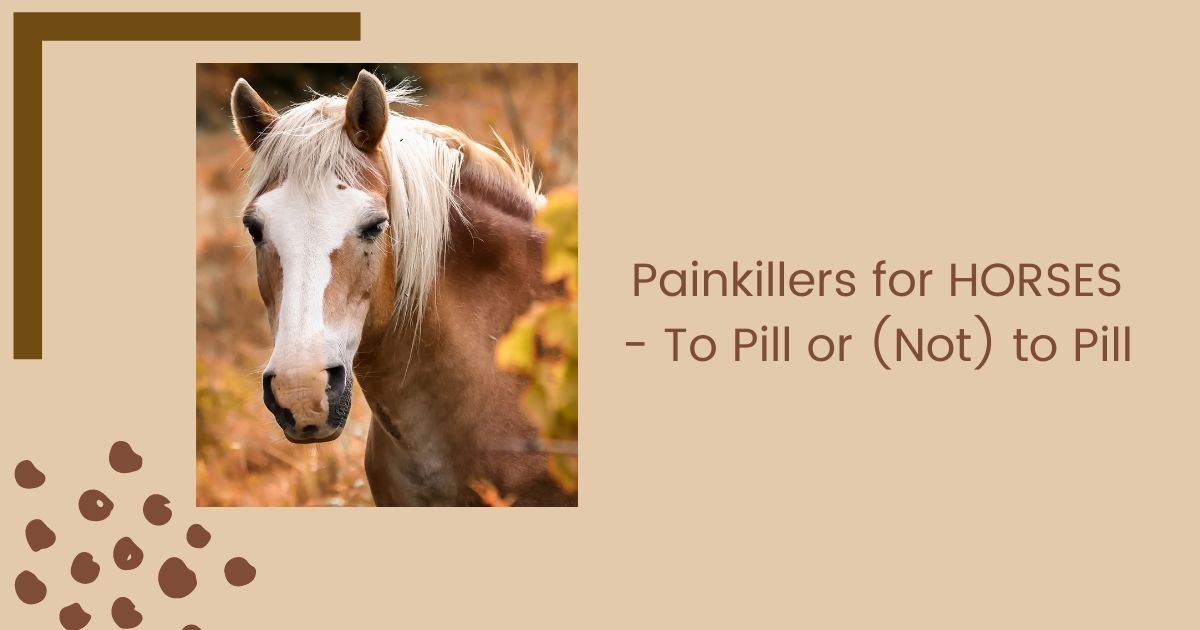If your equine companion seems to be in a bit of discomfort – hold your horses before dishing out just any old painkillers for horses. Whether it is leftover medication from a previous issue or an over-the-counter drug, self-medicating with equine anti-inflammatory drugs can have serious consequences.
If you suspect your horse is in significant pain, always consult your attending veterinarian before giving your horse any pills.
What You Should Know About Equine Anti-Inflammatory Drugs
There are several factors to take into consideration when administering drugs to your horse. Being informed about the type of medication you administer is the first step to managing their pain and knowing what the potential side effects are so that one can avoid serious adverse effects.
NSAIDs
Non-steroidal anti-inflammatory drugs (NSAIDs) are the most commonly employed painkillers used for horses by veterinarians. For example, phenylbutazone, Flunixin Meglumine, Firocoxib, Ketoprofen, or Carprofen are prescription medications used to treat various painful equine ailments.
Vets use these medications judiciously because their benefits can outweigh their potential adverse effects if not used appropriately. Excessive use of drugs can cause the following adverse effects:
Injection Site Reactions
Incorrect or unsterile administration of medication can lead to severe cases of infection under the skin or into the musculature. This can sometimes lead to severe or life-threatening tissue death that takes months of intensive care and a lot of financial input to rectify.
Jugular thrombosis is also a big concern when IV injections are incorrectly or unhygienically administered.
Gastrointestinal Issues
Gastric ulceration or dorsal colitis are significant concerns when NSAIDs like Danilon, a type of phenylbutazone, are overused. The incorrect COX pathway can sometimes be inhibited, resulting in gastric ulcerations, so it is imperative to monitor your horse for any signs of gastric ulcers. They can also cause oral ulcers on the tongue or lips.
Signs to watch out for are colic signs or inappetence. To avoid GIT issues, short-term courses of NSAIDs as well GIT protectants should be used as well. Gastric ulcers result in protein loss, and if your horse begins to show signs of ulcers like a pasty diarrhea, total blood protein tests will be a good indicator of potential adverse effects from NSAID use.
Kidney Injury
Inappropriate NSAID use can include overuse, overdose, or administration to a dehydrated horse, resulting in kidney damage. Always consult your vet before using NSAIDs to avoid any adverse effects.
The Importance of Equine Pain Management
The diagnosis of the underlying problem is critical when it comes to managing and treating pain in horses. Quality of life is significantly affected when a horse is in pain, so it is essential to regularly monitor any new or chronic abnormalities and determine if your horse is in any pain.
Pain management in horses will depend on several factors, namely:
- Duration
- Type and
- Severity
The question of whether to pill or not to pill your horse should always be discussed with your veterinarian so that the most appropriate steps are taken to offer fast and effective relief. Pain has a negative impact on behavior, performance, and overall welfare.
Signs That Your Horse is in Pain
Horses can sometimes be quite stoic as an inbuilt survival mechanism, so it is vital to have measures in place to monitor your horse daily for signs of pain or discomfort. Subtle or non-specific manifestations of pain can include the following changes:
Behavioral Changes
As an owner, you know your horse best, but trusted stable managers or grooms could also start noticing behavioral changes that indicate pain. For example:
- Lethargy or depression
- Aggression, restlessness, agitation, or nervousness
- Headshaking
- Decreased interest in surroundings or becoming withdrawn
- Rolling
- Vocalization or groaning
- Decreased or no appetite

Postural or Facial Changes
Horses have normal and comfortable positions as well as regular gaits, but should they start with the following signs, they could be in some discomfort:
- Arched back, lowered head, altered stance.
- Kicking or looking at their flank, stretching excessively, constant weight shifting, pawing, reluctance to move or stand.
- Clenched jaw, vacant stare, or flared nostrils.
Clinically Obvious Signs of Pain
These overt signs of pain can help you or your vet determine what the underlying issue is if you know what you’re looking for:
Lameness
Intermittent or non-weight-bearing.
Ocular pan
Teary eyes with discharge, refusing to open the eye, or increased sensitivity to light and only partially opened lids.

Dental pain
Inappetance, chewing abnormalities or dropped food, head tilt or swelling, and increased head shaking or nodding.
Noticing a horse’s pain is the first step in pain management, so be sure to carefully monitor and interpret pain-related behavior.
7 Over-The-Counter Painkillers for Horses That Are Safe to Use
Should a veterinarian not be available and you feel your horse is uncomfortable – there are a few options for over-the-counter drugs. Still, the side effects can be complex or unpredictable.
Always offer full disclosure of any medication administered to ensure your veterinarian gains full insight into possible underlying symptoms, which could now be masked by medication or possible future adverse drug effects.
- Ibuprofen
Ibuprofen is an NSAID available over the counter, but USEF has not yet approved it for use in horses. It can be used to alleviate inflammation, but the incorrect dose can cause harmful GIT adverse effects. However, vets can prescribe ibuprofen for off-label use under specific conditions like tendon injuries.
Ibuprofen is a prohibited substance in competing horses, and its metabolic clearance time is unpredictable.
- Aspirin
Aspirin is regularly used to alleviate pain and fever. It is also often used in laminitic and hypercoagulable disorders like septicemia. Chronic use may result in GIT adverse effects. Aspirin is also used off-label as it has not yet gained USED for FDA approval.
Aspirin affects coagulation, so avoid this drug at least two weeks before any major surgery.
- Paracetamol (Tylenol)
Paracetamol in equines is not a strong painkiller, but it does act synergistically with other pain medication to alleviate inflammation, especially in laminitis. Unfortunately, no licensed product is available for horses, but if you consult your veterinarian, they can guide you on what formulations can be adapted for your horse.
- Celecoxib
Celecoxib is a nonsteroidal anti-inflammatory drug frequently used to treat arthritis in humans with minimal gastrointestinal side effects compared to traditional NSAIDs. TIt can be administered to horses as a short-term pain adjunctive therapy.
- Diphenhydramine (Benadryl)
Although diphenhydramine is not a pain killer, it can be used to decrease discomfort caused by hypersensitivity reactions in horses. The swelling and itching caused in allergic horses can result in significant self-excoriation and trauma if they scratch continuously.
Prolonged use is not advised, and it should only be used in emergencies or until a vet can attend to your horse.
- CBD
CBD products have grown in popularity over the past few years due to their excellent anti-inflammatory properties seen in many human trials. The data for CBD is still not concrete, so it is used extra-label, but it does show a lot of promise in patients with arthritis.
Always purchase CBD products from trusted brands that make use of good manufacturing practices (cGMP) and have third-party lab certificates of analysis available for every batch of oil.
Good CBD products will have guarantees and good sales support. Ensure that the product is suitable for animals without any harmful additives and has a concentration of between 20 mg/mL and 60 mg/mL.
- Wound antiseptic ointment or washes
Chloroxylenol or Chlorhexidine are often used to clean wounds. Although they do not have pain-relieving properties, they do have prophylactic benefits to prevent your horse from getting a painful infection if used correctly.
Always remember to dilute these solutions according to directions to avoid damaging the tissue and do not use daily – only use initially to clean a fresh wound.
Other Options for Pain Management in Horses
Medication is not the only option of pain relief in horses, and if your horse does suffer from chronic conditions, there are alternatives for pain management. Depending on the pain origin. Some other options include:
- Physiotherapy
- Remedial shoeing
- Acupuncture
- Weight management

Can You Give Human Painkillers to Horses?
Human pain killers are sometimes used off-label in multi-modal pain approaches or as alternative treatment options. However, prescription medication specifically researched and formulated for horses is the golden standard of treatment because of its specificity for equine pain and inflammatory pathways.
Human medication is not intended for equine administration for several reasons. Firstly, the concentrations are often too low and require large quantities of tablets which can be expensive and impractical. Secondly, the route of administration is usually orally, which can prove difficult in large horses that require large concentrations of medication.
Equines also have very different physiology and metabolisms to humans, affecting how a horse processes and excretes medications. This may affect whether or not your horse can compete in competitions that test for prohibited substances as some drugs linger in a horse’s system, and this may lead to potential competition exclusion.
The FDA does not often list human medication for equine use unless it has been tested thoroughly and is a better alternative to available veterinary drugs. Veterinarians will always opt for a licensed medication approved by the FDA for horses as they are legally obliged to follow best practice legislation.
Best practice legislation ensures both human and animal safety. For example, the overuse of phenylbutazone in horses is banned in countries where horses are used as protein sources because it results in bone marrow suppression when consumed by humans.
The Final Neigh (Say)
Before giving a horse human pain medication, something to consider is the possibility that your insurance company may reject your claim if an unlicensed non-approved medication was administered.
Your insurance company may refuse to pay out if there are severe complications from secondary adverse effects or a significant underlying medical condition that was masked due to off-label medication administration.
Insurance companies often decline to settle any claims when an illegal unlicensed medication was used as treatment. Experimental and homeopathic medicines are excluded from Equine insurance policies.
At the end of the day, we always want what is best for our horses, so always apply best practice principles when managing your horse’s pain. In addition, always follow recommendations from your veterinarian and consult them before administering any medication.
